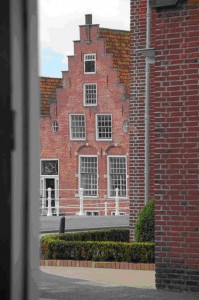This is really great - I´m presently aboard our boat in Enkhuizen harbour, and thanks…
Tradition
 I’ve read about 2/3’ds of Simon Schama’s ‘Rembrandts Eyes’, it is fascinating!
I’ve read about 2/3’ds of Simon Schama’s ‘Rembrandts Eyes’, it is fascinating!
The picture I’ve posted is one taken this morning. We were eating ice-cream – a very holiday-ish thing to do – and looking across the street at a scene that could have been a Vermeer.
I notice this kind of thing because of the Schama book. He makes the 17th century, and Amsterdam in particular, come alive! His Rembrandt is a painter that is rooted in this own time and place, but also measures himself against the top of the European art world of his time – especially his great example: Rubens.
Now I’ve always wondered why I find painters like Rubens so boring. Schama gave me a pointer. He places Rubens as part of the catholic tradition – trying to make his viewers take part in a spectacle, to engage his public in an overwhelming – and uplifting – experience. Which is why Rubens does a lot of – in my eyes – weird and dramatic stuff with colour and perspective, which is meant to make me part of the picture he paints. In my eyes, steeped in the dutch protestant tradition, he usually tries too hard.
Rembrandt is one of the painters inventing a new iconography for the protestant movement that emerged in his time and age in the Netherlands. Protestants are the people of the Book, not the Sacrament. So their iconography stresses thought and contemplation, not emotion and feeling. And Rembrandt did a balancing act between portraying these people as sober and contemplative on the one hand and rich and outgoing on the other. Which he does by portraying his patrons in their sober ‘sunday best’, but lavishing attention on the exuberant furs and laces they added because they wanted their bit of luxury, too. Small gratifications for the senses they distrusted and decried.
If I am part of any tradition, this must be the one.
| « Living Rembrandt | <-- previous post | next post --> | Embarrassment of Riches » |
|---|






